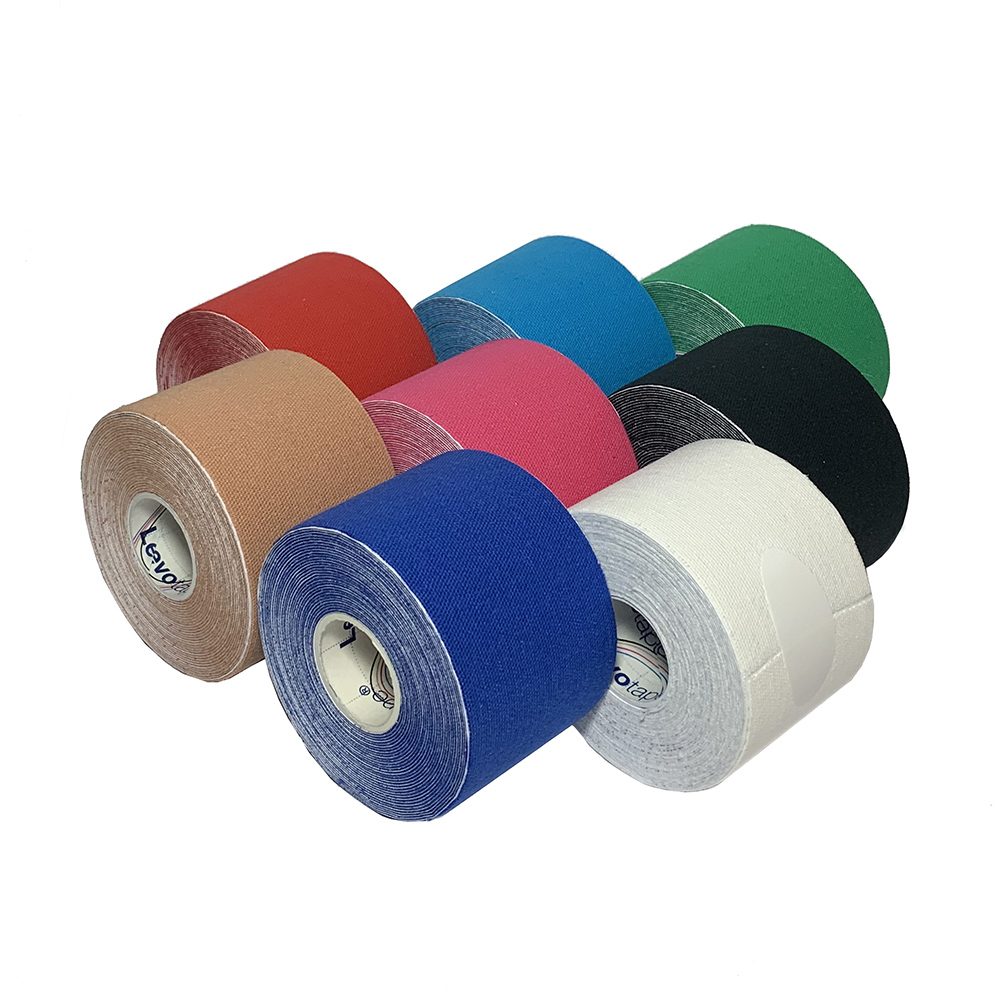
Guide to the best Kinesiology Tapes
What is Kinesiology Tape?
Kinesiology tape, also referred to as “Kineso Tape”, is a fine cotton adhesive tape with a thickness similar to the skin. It uses an acrylic super glue in a wave pattern and is covered with backing paper, but the history of Kinesiology Taping has shone a light on the practice of sports tape and the role of the Sports Physio in recent years more so than any other technique in Physiotherapy. With exposure of these multi-coloured tapes at the Olympic Games and used by high profile footballers, the use of Kinesio and kinesiology tapes has spread like wild fire.
Levotape Kinesiology Tape (8 Colours) 5m x 5cm
Having developed the Kinesio Taping Method in the late 70’s Japanese Chiropractor Kenso Kase collaborated with Japanese manufacturer Nitto Denko to develop a lightweight elasticated cotton stretch tape. They used a hypoallergenic acrylic adhesive, and the taping method was developed to provide a “soft touch” to the skin, in contrast to the mechanical methods being used in athletic taping with zinc oxide tapes or elastic adhesive bandages.
What Kinesiology Tape do I need?
Since the Kinesio organisation chose to move production of the tape away from Japan to China in 2006 there has been an explosion of brands come to market.
Nitto Denko collaborated with European partners such as Siggi Breitenbach in Germany, Zibi Sliwinski in Poland and Vivomed in the UK to develop the brand K-Active and retain the original Japanese tape. While this was successful for a while, at Vivomed we decided that it was time to develop our own tape. Using Japanese medical grade acrylic adhesive and top quality cotton cloth we embarked on trials to create LEVOTAPE. This necessitated careful assessment of adhesive concentrations and elasticity of the fabric before bringing the tape to market. We also recognised that in general Kinesio Tapes were over priced and as such Levotape became known by physios for being a quality tape at a reasonable price.
Other Kinesiology Tapes have followed, some cheap and poor quality and others such as Rocktape following the high price, loud marketing principles. When deciding how to choose therefore, there are a few principles to look at:
- The cloth – Top quality cloth won’t fray at the cut edges
- Water-resistant – Does the waterproofing allow the tape to be used effectively in sport?
- Stretch – Is the elasticity uniform, and does it give adequate recoil.
- Backing paper – Manufacturers should apply tape to the backing paper with uniform stretch.
- Stickiness – Must consider balance between adhesiveness and risk of blistering
- Price – Are you getting value for money?
At Vivomed we provide a range of Kinesiology tapes so you can decide for yourself, but clearly we recommend LEVOTAPE
How to use Kinesiology Tape
For many years, firstly with Zibi Sliwinski, Siggi and others we at Vivomed provided Kinesio Taping Courses across the UK and Ireland, later with physiotherapist Mike Jones we developed the teaching further and designed and created courses at prestigious venues such as Wembley. With the advent of YouTube many practitioners chose to go online to learn the taping Techniques, so we created an online kinesiology taping course to provide a professional teaching portal for Physios, Doctors, Sports Therapists, Chiropractors and Osteopaths.
The Web provides many versions of how Kinesio Taping should be practiced but in general The Kinesio Taping principle proposes five main taping methods which are suggested to create therapeutic effects by way of a recoil and gentle lifting and re-positioning of the skin and tissue:
Muscle Technique



Tissue Lift


Lymphatic Technique



Corectional Technique



Fascia Technique
- Muscle Technique – Here the muscle is stretched, not the tape and when the muscle returns to neutral the skin is gently lifted.
- Pain relief Technique – Sometimes known as “Tissue Lift” this method involves applying applying a stretch of between 75 and 100% to the tape, placing it over the area of pain, gently flattening the ends, and the consequent recoil causes the skin to be lifted.
- Lymphatic Technique – The tape is cut in a fan which is placed over an area of inflammation or bruising with the uncut end directed towards a lymph node.
- Fascia Technique – With a stretch of between 25 -50% the fascia can gently be re-positioned in an effort to facilitate improved function
- Correctional Technique – This uses a 50 -75% stretch to create a mechanical re-positioning of tissues
Having said this the use of K-Tape is very personal and is a technique that can be developed over time and through practice, but we would advise attending a course to get the basics.